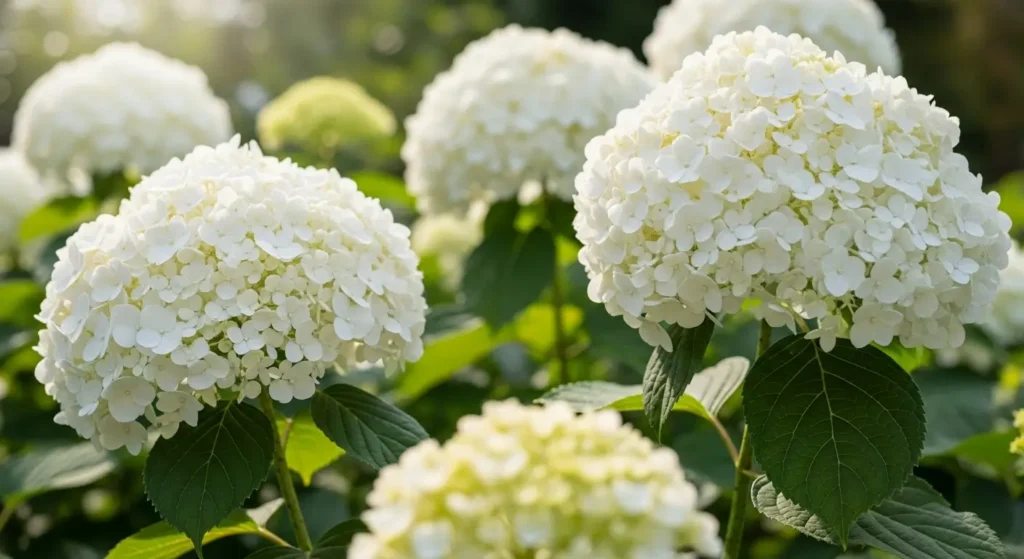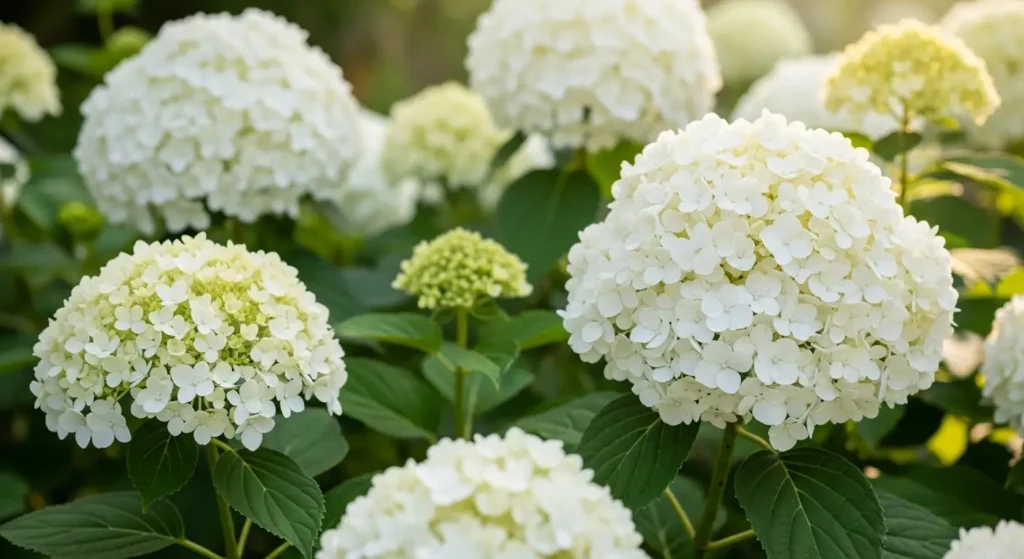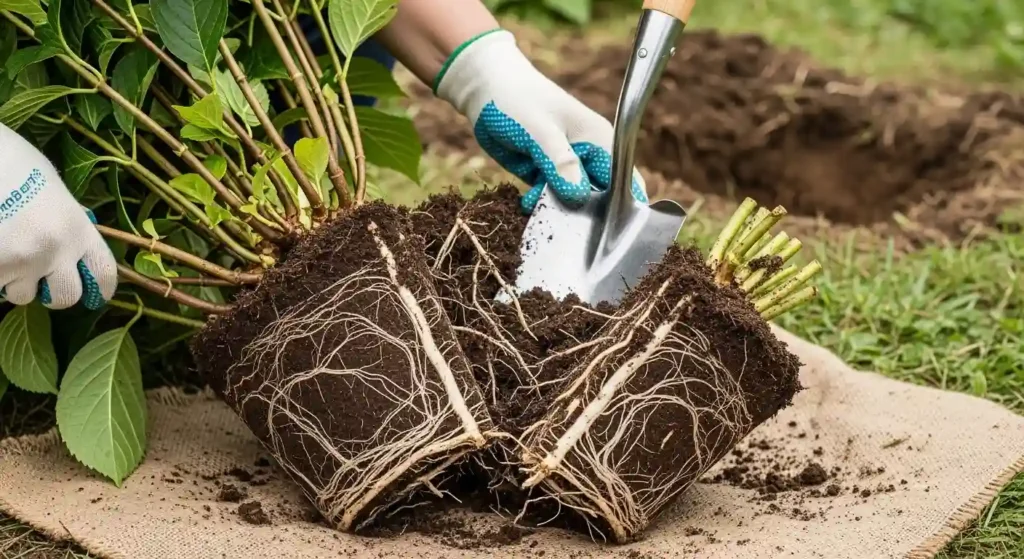
In This Article
Annabelle hydrangea is one of America’s most beloved flowering shrubs, guaranteed to turn heads in any garden. With huge, snowball-like white blooms reaching up to 12 inches across, this native eastern U.S. beauty puts on quite a show from early summer through fall. Thriving in zones 3-9, it handles both cold winters and warm summers effortlessly. It’s hard to find a more reliable bloomer for serious visual impact without much fuss.
Plant Care Card
| Attribute | Details |
|---|---|
| Common Name | Annabelle Hydrangea, Annabelle Smooth Hydrangea |
| Botanical Name | Hydrangea arborescens ‘Annabelle’ |
| Family | Hydrangeaceae |
| Plant Type | Deciduous flowering shrub |
| Mature Size | 3-5 feet tall, 4-6 feet wide |
| Sun Exposure | Full sun to partial shade |
| Soil Type | Well-draining, rich in organic matter |
| Soil pH | 5.5-7.0 (slightly acidic to neutral) |
| Hardiness Zones | USDA 3-9 |
| Native Area | Eastern United States |
| Toxicity | Mildly toxic to pets and humans if ingested |
Annabelle Hydrangea Care
This variety is considered easy to moderate for most gardeners, making it perfect for beginners. The following sections will walk you through everything from light and water to propagation and common problems. You’ll love how forgiving this annabelle hydrangea is!
Light
Annabelle hydrangea adapts well to various light conditions throughout most gardens. It thrives in full sun to partial shade, though the ideal spot offers morning sun with afternoon shade, especially in warmer climates. In northern regions, full sun works beautifully and produces the most abundant blooms.
However, in southern gardens, too much afternoon sun can cause wilting during peak summer heat. If your annabelle hydrangea gets insufficient light, you’ll notice fewer blooms and leggy, weak growth. On the flip side, excessive direct sunlight in hot areas may scorch leaves and cause flowers to fade faster. A spot that gets at least 4-6 hours of morning sun is perfect for maximum blooms.
Soil
This shrub prefers well-draining soil rich in organic matter like compost, aged manure, or leaf mold. The soil should hold moisture without becoming waterlogged, as sitting in soggy conditions leads to root rot. A loamy texture works best for the annabelle hydrangea, providing both drainage and nutrient retention.
For a simple DIY mix, combine equal parts garden soil, compost, and perlite or coarse sand. According to the Oregon State University Extension, testing drainage before planting helps prevent problems add sand or bark if water pools, or add compost if drainage is too rapid. This ensures your plant develops strong, healthy roots from the start.
Water
Water consistently to keep soil evenly moist but never soggy throughout the growing season. During spring and summer, water deeply once or twice weekly, letting the top 2-3 inches of soil dry out between waterings. Honestly, this annabelle hydrangea will let you know when it’s thirsty droopy leaves that perk up within 30 minutes mean it needs a drink.
Signs of overwatering include brown leaf edges, yellowing leaves, and eventual leaf drop. Underwatering causes wilting that’s more prolonged and stressful to the plant. In summer heat, you may need to water twice weekly, especially in sandy soils. During fall and winter, reduce watering frequency as the plant goes dormant. Similar watering needs apply to spider plant care, another beginner-friendly option that prefers consistently moist but well-drained conditions.
Temperature and Humidity
Annabelle hydrangea tolerates a wide temperature range, thriving exceptionally well in zones 3-9. It handles temperatures from -40°F in winter up to 90°F+ in summer without much complaint. This shrub prefers moderate humidity but adapts to typical household and garden conditions without issue.
However, avoid placing plants near heating vents, air conditioning units, or in areas with strong drafts. Extreme temperature fluctuations stress the plant and can damage flower buds. In very hot climates above 90°F, make sure to provide afternoon shade and consistent moisture to prevent heat stress.
Fertilizer
Apply a balanced, slow-release fertilizer in early spring before new growth emerges on your annabelle hydrangea. A 10-10-10 or similar formula works well, applied at 1 pound per 100 square feet. According to University of New Hampshire Extension, flowering shrubs benefit most from spring applications. Feed again in late spring if desired, but skip fall fertilizing to avoid tender new growth before winter.
Pruning

Prune annabelle hydrangea in late winter or early spring before new growth starts for best results. Since it blooms on new wood, you can cut it back hard without sacrificing flowers a huge advantage for gardeners. Most gardeners cut stems back to 18-24 inches above ground to build stronger, sturdier limbs that better support those massive blooms.
Alternatively, you can cut it all the way to the ground for complete renewal, as recommended by University of Maryland Extension. Remove any dead, damaged, or crossing branches anytime throughout the year. If flower heads droop from weight after rain, consider more aggressive spring pruning to develop thicker stems.
Propagating Annabelle Hydrangea
The best time to propagate this annabelle hydrangea is during spring and summer when growth is most active.
Propagating by Stem Cuttings
This is the most popular and reliable method for home gardeners looking to multiply their annabelle hydrangea collection.
Materials needed:
- Sharp, clean pruning shears or scissors
- Rooting hormone powder (optional but recommended)
- Small pots with drainage holes (4-6 inch size)
- Well-draining potting mix
Step 1: Take 4-6 inch cuttings from new growth in early summer, choosing stems without flowers for best success. Cut just below a leaf node at a 45-degree angle using sharp, sterilized pruners.
Step 2: Remove leaves from the bottom half of each cutting, leaving only 2-3 leaves at the top to reduce moisture loss. Dip the cut end in rooting hormone powder to encourage faster root development.
Step 3: Insert cuttings into moist potting mix, burying them about 2 inches deep so they stand upright. Place pots in bright, indirect light and keep soil consistently moist but not waterlogged.
Step 4: Cover with a clear plastic bag to maintain humidity around the cuttings and prevent moisture loss. After 3-4 weeks, check for roots by gently tugging—resistance means roots have formed successfully. Transplant rooted cuttings after 6-8 weeks when roots are well-established.
Propagating by Division

Mature annabelle hydrangea plants can be divided in early spring before new growth appears for instant results. Dig up the entire root ball carefully and use a sharp spade to divide it into sections, ensuring each has several stems and healthy roots. Replant divisions immediately at the same depth as the original plant to prevent shock.
Water thoroughly after planting and mulch around the base with 2-3 inches of organic matter. This method works especially well for rejuvenating old, overgrown specimens that have become too large. Like lipstick plant propagation, division provides instant new plants that establish quickly and bloom within the first season.
Potting and Repotting Annabelle Hydrangea
Annabelle hydrangea grows well in large containers for patios and decks. Signs it’s time to repot include roots growing through drainage holes, water running straight through without absorption, or stunted growth despite proper care. Repot every 2-3 years in spring for best results.
When to Repot
Choose a pot 2-3 inches larger in diameter than the current one to accommodate growth. Select a container with multiple drainage holes to prevent waterlogging, which can kill an annabelle hydrangea quickly. Spring is the ideal time before active growth begins and temperatures warm up.
How to Repot
Gently remove the plant from its current pot, loosening any circling roots that may have formed. Fill the new pot one-third full with fresh, well-draining potting mix enriched with compost. Place the annabelle hydrangea at the same depth it was growing previously, then fill around the sides with soil. Water thoroughly and place in its usual spot with appropriate light conditions.
Common Pests and Diseases
Like most flowering shrubs, annabelle hydrangea can occasionally attract pests, though it’s generally quite resistant to problems.
Spider Mites
Look for tiny webbing between leaves and stippled, yellowing foliage that eventually drops prematurely. These pests thrive in hot, dry conditions during summer months. Treat with insecticidal soap or neem oil spray, covering leaf undersides thoroughly where mites hide. Increase humidity around plants to discourage future infestations.
Mealybugs
White, cottony masses appear on stems and leaf joints, causing stunted growth and leaf yellowing in affected areas. Remove with rubbing alcohol applied on a cotton swab for small infestations, or spray with horticultural oil for larger problems that persist.
Scale Insects
These appear as small brown or tan bumps on stems and leaves, sucking plant sap and causing yellowing or weakening. Scrape off manually with your fingernail or a soft brush, or treat with horticultural oil applied directly to affected areas. According to the USDA Integrated Pest Management guidelines, monitoring regularly helps catch infestations early.
Aphids
Clusters of tiny green or black insects gather on new growth and flower buds, causing distorted leaves and sticky residue. Spray them off with a strong water stream from your garden hose or use insecticidal soap every few days until gone completely.
Common Problems with Annabelle Hydrangea
Here’s how to troubleshoot common issues with your annabelle hydrangea:
Yellow Leaves

This is typically caused by three things affecting your annabelle hydrangea. First, overwatering leads to root rot and yellow leaves check if soil is waterlogged and reduce watering frequency immediately. Second, nutrient deficiency, especially nitrogen, causes older leaves to yellow and drop apply balanced fertilizer during the growing season as needed.
Third, natural aging makes lower leaves yellow and drop, which is completely normal. Improve drainage if water pools around the base, and make sure to maintain consistent moisture without saturation. Similarly, ficus audrey experiences yellowing from overwatering issues and responds to the same solutions.
Brown Leaves
Low humidity is the primary culprit for brown tips on your annabelle hydrangea, especially indoors or during hot, dry weather. Increase watering frequency slightly during heat waves and mulch around the base to retain moisture in the soil. Additionally, fluoride or chlorine in tap water causes browning on sensitive plants let water sit overnight before using or switch to rainwater.
Finally, underwatering during peak summer heat leads to crispy brown edges that won’t recover. Water deeply and consistently, especially when temperatures exceed 85°F. Much like red chrysanthemum care, consistent moisture prevents most browning issues.
Drooping or Wilting Leaves
This signals watering problems either too much or too little for your annabelle hydrangea. If soil is dry several inches down when you test it, the plant needs water immediately. If soil is soggy and smells sour, you’re overwatering and risking root rot that can kill the plant.
Water deeply when the top 2-3 inches dry out between applications. After heavy rain, wilting may occur due to waterlogged soil improve drainage by adding organic matter or creating raised beds. Plants like peperomia also show similar wilting symptoms when watering needs aren’t met properly.
Leggy Growth / Sparse Foliage
Insufficient light causes thin, stretched growth with few flowers on your annabelle hydrangea. Move the plant to a location with more morning sun and better light exposure throughout the day. Prune back leggy stems to 18-24 inches in late winter to encourage bushier, fuller growth from the base. Like wandering jew plant care, proper light makes all the difference in compact growth.
FAQ
Do Annabelle hydrangeas like sun or shade?
They prefer full sun to partial shade for optimal flowering. Morning sun with afternoon shade produces the best blooms in most climates, though northern gardeners can provide full sun successfully.
How big does Annabelle hydrangea get?
Mature plants typically reach 3-5 feet tall and 4-6 feet wide at maturity. With minimal pruning, some specimens may grow slightly larger in ideal conditions with ample moisture and nutrients available.
Do you prune Annabelle hydrangeas in the fall?
No, prune in late winter or early spring instead for best results. Since they bloom on new wood, wait until before new growth emerges to avoid sacrificing any flowers on your shrub.
Where is the best place to plant Annabelle hydrangeas?
Plant in a spot with morning sun, afternoon shade, and consistently moist, well-draining soil enriched with compost. Avoid hot, exposed sites and provide protection from strong winds for optimal performance and beautiful blooms.
